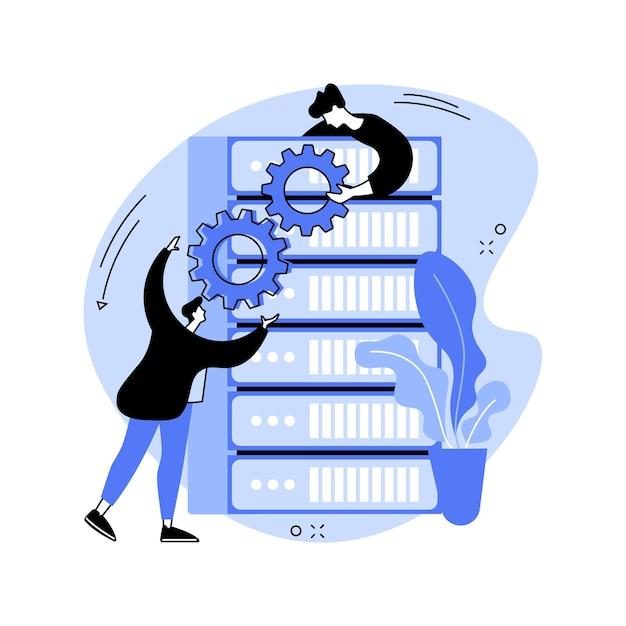Are you considering migrating from Oracle EBS to Oracle Cloud, but are unsure about where to start? Oracle Cloud implementation promises better performance, scalability, and reduced costs, but it is not without its challenges. Many businesses are struggling with Oracle Cloud migration hurdles, and it is easy to see why. From understanding the intricacies of different systems to developing implementation plans that align with business objectives and timelines, the process of implementing Oracle Cloud can be daunting.
One of the most significant hurdles when it comes to Oracle Cloud implementation is understanding the key differences between Oracle EBS and Oracle Cloud. For those in the know, it is clear that Oracle Cloud provides a more comprehensive and integrated system, but understanding how to make the switch can be overwhelming. Developing an effective strategy that aligns with business objectives requires a thorough understanding of the benefits and challenges, as well as an analysis of the costs and resources required.
Another critical challenge during the implementation process is overcoming migration issues and minimizing the impact on business operations. While Oracle Cloud promises greater flexibility and agility, businesses must ensure that they can effectively transfer data, applications, and other resources, all while minimizing the downtime that could negatively impact the bottom line.
Additionally, implementation projects in Oracle Cloud require a comprehensive understanding of the platform, its functionalities, and limitations. While the migration process has its challenges, the project development phase can be the most significant hurdle of all. It is important to consider all of the elements that will be involved in the implementation plan, including timeline, budget, resources, and potential risks.
Ultimately, implementing Oracle Cloud can be a complex and challenging process, but with the right strategy and support, it can provide significant benefits for businesses. In this comprehensive blog post, we will delve into the challenges and solutions related to Oracle Cloud implementation, as well as the benefits and limitations of Oracle EBS and Oracle Cloud. Additionally, we will explore the how-to’s of creating an implementation project in Fusion, with a focus on overcoming the challenges of migration. Join us and learn how to overcome the challenges of implementing Oracle Cloud to gain a competitive edge in the industry.
Challenges faced during Oracle Cloud Implementation
Implementing the Oracle Cloud can be a daunting task for businesses, as it involves a lot of technicalities and complex processes. Here are some common challenges that businesses face during an Oracle Cloud implementation:
Technical complexity and customization
Most businesses have a unique set of requirements, which cannot be met by a one-size-fits-all approach. Oracle Cloud offers a wide range of features, and choosing the right ones that cater to the business’s specific needs can be challenging. Moreover, integrating Oracle Cloud with the existing systems of the business can be a herculean task, especially when these systems are customized and complex.
Migration of data and applications
Migrating data and applications to Oracle Cloud can be a time-consuming and complex process. Businesses have to ensure the safety and integrity of sensitive data during the migration process. Moreover, they need to assess the existing data and applications to ensure compatibility with the cloud environment, which can be a cumbersome task.
Budget constraints
Oracle Cloud implementation involves a significant investment, and not all businesses have the required funds. Besides, many businesses underestimate the costs of implementation, and this can lead to cost overruns. Businesses need to plan and budget for the implementation process and be mindful of the hidden costs associated with it.
Resistance to change
Implementing a new system can be met with resistance from employees who are resistant to change. They may feel uncomfortable with new workflows and processes, and this can lead to a decreased rate of adoption. Businesses must ensure that they provide the necessary training and assistance to employees to facilitate a smooth transition to the new system.
In conclusion, while Oracle Cloud implementation comes with its own set of challenges, businesses can mitigate them by proper planning, choosing the right implementation partner, and ensuring that their employees are well-educated and trained for the change.
Oracle EBS vs Oracle Cloud
When it comes to implementing an enterprise resource planning (ERP) system, two popular options are Oracle EBS and Oracle Cloud. While both systems have their strengths and weaknesses, deciding which one to choose can be a daunting task. In this section, we’ll compare the two systems to help you make an informed decision.
Oracle EBS
Oracle EBS, or Oracle E-Business Suite, is a collection of business applications that help organizations streamline their business processes. It includes modules for financial and supply chain management, human resources, and customer relationship management, among others.
One of the main advantages of Oracle EBS is that it’s a mature product with a stable and proven track record. It’s also highly customizable, allowing organizations to tailor it to their specific business needs.
However, Oracle EBS has some limitations. It requires a lot of hardware and infrastructure to run, and maintaining the system can be complex and costly. Additionally, it’s not designed to take advantage of the latest cloud technologies, so organizations may miss out on some of the benefits of cloud computing.
Oracle Cloud
Oracle Cloud, on the other hand, is a cloud-based ERP system that’s designed to take advantage of the latest cloud technologies. It includes modules for financial management, human capital management, supply chain management, and more.
One of the main advantages of Oracle Cloud is that it’s highly scalable and flexible. It’s designed to run on the cloud, so organizations don’t need to worry about maintaining hardware or infrastructure. Additionally, it includes features like real-time analytics and machine learning that can help organizations make better business decisions.
However, Oracle Cloud is a relatively new product, so it may not have the same level of maturity and stability as Oracle EBS. Additionally, it’s less customizable than Oracle EBS, which may be a drawback for organizations with very specific business needs.
Both Oracle EBS and Oracle Cloud have their strengths and weaknesses, and the choice between the two will depend on the specific needs of your organization. If you’re looking for a mature product with a proven track record and high customizability, Oracle EBS may be the better option. If you’re looking for a highly scalable and flexible system that takes advantage of the latest cloud technologies, Oracle Cloud may be the way to go. Ultimately, the most important thing is to thoroughly research both options and choose the one that best fits your organization’s needs.
Oracle Cloud Migration Challenges
Migrating your enterprise application to the cloud can be a daunting task, and the Oracle Cloud is no exception. In this section, we will discuss some of the most common challenges faced during the migration process to the Oracle Cloud.
Choosing the Right Migration Strategy
One of the most significant challenges is determining the right migration strategy. A lift-and-shift strategy may work for some applications, but others may require significant changes to make them cloud-compatible. Moreover, it’s not always clear which applications should migrate to the cloud first, making it challenging to create a priority list for migration.
Security and Compliance Concerns
Security and compliance is another top concern when migrating to the Oracle Cloud. Enterprises store valuable and sensitive information on their applications, making them a prime target for hackers. Ensuring that your data is secure and compliant with industry standards can be a challenging and time-consuming task.
Compatibility and Integration Issues
The compatibility of your application with the Oracle Cloud infrastructure and other cloud services is another hurdle. Applications may need to be re-platformed or re-architected to make them compatible. Additionally, integration with other systems and applications can be a challenging task, especially when dealing with legacy systems or those that work on a different technology stack.
Performance and Scalability Issues
Performance and scalability issues can arise due to factors like network latency, I/O bottlenecks, and resource constraints. Ensuring that your application performs optimally and scales efficiently to meet changing business needs is a critical challenge in moving to the cloud.
Staffing and Skill Gap
Migrating to the Oracle Cloud can often require specialized skills and expertise. Some enterprises may not have these skills in-house and may find it challenging to hire the right talent. Additionally, some employees may require retraining to keep up with the latest technology trends and tools.
In conclusion, understanding the challenges involved in migrating to the Oracle Cloud can help you minimize risks and develop a better migration plan. Careful planning and execution can help overcome these challenges and achieve a successful migration.
What is Oracle Cloud Implementation
Oracle Cloud Implementation refers to the process of setting up and utilizing Oracle Cloud services in a business enterprise. It involves configuration, migration, and customization of business operations on the cloud. The Oracle Cloud platform is designed to help organizations transform their business and IT operations to streamline processes and enhance efficiency. Organizations can use Oracle Cloud services, such as SaaS, PaaS, and IaaS, to develop new applications, migrate existing applications to the cloud, and build and host new environments.
The Benefits of Implementing Oracle Cloud
Oracle Cloud implementation can greatly benefit an organization by providing flexibility and scalability to meet changing business needs. It can help reduce costs and increase operational efficiency by streamlining business processes. Cloud services such as PaaS and IaaS offer the ability to develop, deploy, and manage applications on the cloud quickly and easily. With SaaS, companies can access pre-built applications and tools to manage their business needs without having to invest in expensive on-premise software systems.
Understanding the Challenges of Implementing Oracle Cloud
Although Oracle Cloud implementation offers many benefits, there are several challenges that companies face when migrating to the cloud. Some of these challenges include:
1. Integration with Legacy Systems
One of the significant challenges of implementing Oracle Cloud is integrating it with existing legacy systems. These systems may have complex architectures, and the integration process may require significant time and resources.
2. Data Security and Privacy
Another challenge is ensuring data security and privacy when moving data to the cloud. Companies must consider data security and privacy regulations when migrating to the cloud.
3. Lack of In-House Expertise
Organizations may also face the challenge of limited in-house expertise in Oracle Cloud technology. It may become necessary to seek the services of cloud experts to help with the implementation of Oracle Cloud services.
4. Cost and ROI
Finally, the cost of implementing Oracle Cloud services is a significant challenge for many organizations. Companies must consider the return on investment (ROI) when making decisions about implementing Oracle Cloud services.
Overall, Oracle Cloud implementation is an exciting and transformative process. Companies can experience significant business benefits from implementing cloud services like SaaS, PaaS, and IaaS. However, the challenges associated with migration require careful consideration and planning to ensure a successful and smooth transition to the cloud.
How to Create an Implementation Project in Fusion
Implementing Oracle Cloud Solutions can be challenging, but it can also be very fruitful. One of the essential steps in implementing Oracle Cloud solutions is to create an implementation project in Fusion. In this section, we’ll show you how to create an implementation project in Oracle Fusion.
Get Familiar with the Implementation Projects Interface
The first step in creating an implementation project in Fusion is to get familiar with the interface. The implementation projects interface comprises several components, including the Navigator menu, the Implementation Projects menu, the Details screen, and the Project Flow screen.
Create a New Project
To start creating your implementation project, navigate to the Implementation Projects menu, click on the “Create Implementation Project” button, and fill in the relevant project details, including the project name, description, start and end dates, and project team.
Define Project Scope
The next step is to define your project scope. In this step, you’ll need to identify the features you want to implement, the business processes, and the corresponding application areas. Type in the necessary information and specify the scope of your project.
Plan Your Project
In this step, you’ll define your project’s timeline, format, and governance structure. The timeline includes the start and end date, as well as milestones and timelines. You’ll also decide the best governance structure and the communication strategy for the team.
Assign Resources
After defining your project plan, you’ll assign resources to the different tasks. Specify the roles and responsibilities of the stakeholders involved in the project and ensure that everyone has access to the appropriate tools and resources needed to complete their tasks.
That’s it! You’ve learned how to create an implementation project in Fusion. Creating an implementation project in Fusion is the first step towards a successful implementation of Oracle Cloud solutions. Ensure that you have a clear project plan, scope, and timeline. By following these steps, you can simplify the implementation process and achieve success with Oracle Cloud.



